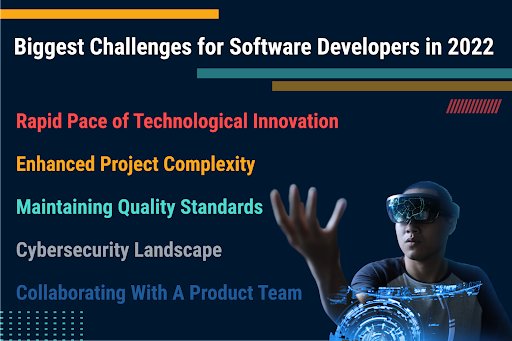Biggest Challenges for Software Developers in 2022

As technology advances, software developers must continually adapt to stay ahead of the curve. New tools and programming languages are being created all the time, and it can be challenging to keep up with the latest trends. In addition, software developers face the difficult task of delivering highly effective code within tight deadlines — in a world increasingly under the threat of cybersecurity attacks. To meet these challenges, developers need to be proactive in their learning. Keeping up with the latest trends, reading industry news, and attending conferences are all essential for staying on top of the ever-changing landscape of software development. By staying informed on these issues and adapting to new trends, developers can ensure that they remain at the forefront of expanding their skillsets and contributing innovative solutions.
Rapid Pace of Technological Innovation
The pace of technological innovation is accelerating at an unprecedented rate — especially after the pandemic. With innovations like no-code apps, quantum computing, and blockchain technologies on the rise, consumers are increasingly open to new technological updates that might make their lives easier. For software developers, this presents a unique challenge. Not only do they need to keep up with the latest technological changes, but they also need to anticipate future trends.
To stay ahead of the curve, developers must continuously learn new programming languages and technologies. As software developers, this practice not only helps you deliver more elevated code but also improves your own programming skills. Software developers should also seek frequent communication with other developers to discuss best practices and grow their craft. It's also beneficial to have a substantial understanding of the business in which they are developing software. Only by constantly evolving their skills and knowledge can developers hope to keep up with the ever-changing landscape of technology.
Enhanced Project Complexity
When it comes to software development, one of the biggest challenges is aligning expectations to an outcome. This gap is often made more difficult by evolving or unspecific requirements -- primarily due to changing client demands or poorly planned projects. In other words, the end goal may change over time or be difficult to pinpoint from the outset. As a result, developers can easily find themselves working on a project that doesn't meet the needs of their clients or a task that becomes increasingly complex due to a lack of direction.
To avoid this issue, it's essential to set clear expectations from the start of a project and stay involved throughout the process to ensure the team is on the same page. Product teams should work closely to define the scope of the project capabilities, incorporate data-driven user feedback into the design, and create comprehensive and clear acceptance criteria to use as guidelines for the development project. Doing so can help ensure that your software development project meets its objectives and leaves your clients satisfied.
Maintaining Quality Standards
As any software developer knows, delivering quality code is essential to success. However, maintaining a high-quality level can be challenging in the face of tight deadlines and ever-changing specifications. That's why product teams need to invest in quality assurance infrastructures, such as automated testing tools and continuous integration systems. With the right tools, developers can focus on writing code that meets the end user's needs rather than worrying about ensuring the code is bug-free.
In addition, developing their coding agility with quality in mind is crucial. By cutting corners or ignoring minor errors, you may miss important elements that could lead to failures in your system. In developing a robust quality assurance practice, developers must establish strategic test criteria, scenarios, and edge cases to ensure a holistic code review. Investing your time in fostering this mentality as you develop will lead to better software for your clients.
Cybersecurity Landscape
A significant rise in the number of cyber attacks in recent years means companies across industries are left more vulnerable to new threats. As a result, more and more organizations are placing a greater emphasis on software security. As a software developer, it's crucial to be proactive in addressing security to ensure the protection of your code and the stability of your client's important data.
As a software developer, you can take a few tactical steps to enhance your development practice with security in mind. For one, several built-in security features in most programming languages can be used to help prevent breaches. Regular code reviews can also help identify potential vulnerabilities. Finally, investing in penetration testing can give you a better understanding of your system's weaknesses and how they can be exploited. A third-party simulation of an attack can provide the vital data you need to make adjustments in your code. By taking these steps, you can help to protect your organization from the damaging effects of a software security breach.
Collaborating With A Product Team
One of the challenges that software developers face when working in a product team is that they are often required to collaborate closely with people from other disciplines, such as UI/UX designers and product managers. This dynamic can be complicated, as developers may have different ways of approaching problems and resolving issues.
To combat some of these issues, try to establish clear communication channels with other team members. This can help you stay up-to-date on their work and ensure everyone is on the same page. Additionally, document your work so that others can easily understand it. Finally, don't be afraid to ask for help with your developer tasks when you need it. By working together and communicating openly, team members can ensure that everyone is on the same page and that the final product meets the needs of all stakeholders.
Take the first step to your new remote career!






